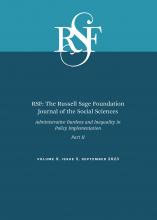Research Article
Open Access
The Effects of Administrative Burden on Program Equity and Performance: Evidence from a Natural Experiment in a Foreclosure Prevention Program
Stephanie Casey Pierce, Stephanie Moulton
RSF: The Russell Sage Foundation Journal of the Social Sciences September 2023, 9 (5) 146-178; DOI: https://doi.org/10.7758/RSF.2023.9.5.07
Stephanie Casey Pierce
aAssistant professor in the Political Science Department at the University of Tennessee, United States
Stephanie Moulton
bProfessor at the John Glenn College of Public Affairs at The Ohio State University, United States

REFERENCES
- ↵
- Agarwal, Sumit,
- Gene Amromin,
- Itzhak Ben-David,
- Souphala Chomsisengphet,
- Tomasz Piskorski, and
- Amit Seru
- ↵
- Aiken, Claudia,
- Ingrid Gould Ellen, and
- Vincent Reina
- ↵
- Ali, Sameen A. Mohsin, and
- Samia W. Altaf
- ↵
- Baekgaard, Martin, and
- Tara Tankink
- ↵
- Baum, Christopher F., and
- Mark E Schaffer
- ↵
- Bertrand, Marianne,
- Sendhil Mullainathan, and
- Eldar Shafir
- ↵
- Bhargava, Saurabh, and
- Dayanand Manoli
- ↵
- Boyne, George A., and
- Richard M. Walker
- ↵
- Bozeman, Barry, and
- Mary K. Feeney
- ↵
- Bozeman, Barry,
- Pamela N. Reed, and
- Patrick Scott
- ↵
- Christensen, Julian,
- Lene Aarøe,
- Martin Baekgaard,
- Pamela Herd, and
- Donald P. Moynihan
- ↵
- Chun, Yung,
- Stephanie Casey Pierce, and
- Andrew J. Van Leuven
- CoreLogic Solutions
- ↵
- Cumby, Robert E., and
- John Huizinga
- ↵
- Damanpour, Fariborz,
- Richard M. Walker, and
- Claudia N. Avellaneda
- ↵
- Deshpande, Manasi, and
- Yue Li
- ↵
- Diamond, Rebecca,
- Adam M. Guren, and
- Rose Tan
- ↵
- Doughty, Meghan, and
- Karen J. Baehler
- ↵
- Farrell, Diana,
- Fiona Greig, and
- Chen Zhao
- ↵
- Finkelstein, Amy, and
- Matthew J. Notowidigdo
- ↵
- Foote, Andrew,
- Michel Grosz, and
- Stephanie Rennane
- ↵
- Frederick, Shane,
- George Loewenstein, and
- Ted O’Donoghue
- ↵
- Garver, Douglas, and
- Arlyne Alston
- ↵
- Godard, Mathilde,
- Pierre Koning, and
- Maarten Lindeboom
- ↵
- Goodman, Laurie,
- Walt Scott, and
- Jun Zhu
- ↵
- Graff, Michelle, and
- Maureen Pirog
- ↵
- Heinrich, Carolyn J
- ↵
- Heinrich, Carolyn J
- ↵
- Heinrich, Carolyn J.,
- Sayil Camacho,
- Sarah Clark Henderson,
- Mónica Hernández, and
- Ela Joshi
- ↵
- Herd, Pamela,
- Thomas Deleire,
- Hope Harvey, and
- Donald P. Moynihan
- ↵
- Herd, Pamela, and
- Donald P. Moynihan
- ↵
- Immergluck, Daniel
- ↵
- Jilke, Sebastian,
- Wouter Van Dooren, and
- Sabine Rys
- ↵
- Karikari, John A
- ↵
- Kuka, Elira, and
- Bryan A. Stuart
- ↵
- LeanOhio
- ↵
- LeanOhio
- ↵
- Linden, Ariel
- ↵
- Linden, Ariel
- ↵
- Linos, Elizabeth, and
- Nefara Riesch
- ↵
- Madsen, Jonas K.,
- Kim S. Mikkelsen, and
- Donald P. Moynihan
- ↵
- Maleyeff, John
- ↵
- Masood, Ayesha, and
- Muhammad Azfar Nisar
- ↵
- Mayer, Christopher,
- Edward Morrison,
- Tomasz Piskorski, and
- Arpit Gupta
- ↵
- Moulton, Stephanie,
- Yung Chun,
- Stephanie Casey Pierce,
- Roberto Quercia,
- Sarah Riley, and
- Holly Holtzen
- ↵
- Moynihan, Donald P.,
- Julie Gerzina, and
- Pamela Herd
- ↵
- Moynihan, Donald P.,
- Eric Giannella,
- Pamela Herd, and
- Julie Sutherland
- ↵
- Moynihan, Donald P.,
- Pamela Herd, and
- Elizabeth Ribgy
- ↵
- Nichols, Albert L., and
- Richard J. Zeckhauser
- ↵
- Nisar, Muhammad A
- ↵
- Ohio Housing Finance Agency
- ↵
- Ohio Housing Finance Agency
- Ohio Housing Finance Agency
- ↵
- Ohio Housing Finance Agency
- ↵
- Ohio Housing Finance Agency
- ↵
- Ohio Housing Finance Agency
- ↵
- Pandey, Sanjay K., and
- Patrick G. Scott
- ↵
- Peeters, Rik, and
- Sergio A. Campos
- ↵
- Radnor, Zoe
- ↵
- Rauscher, Emily, and
- Ailish Burns
- ↵
- Special Inspector General for the Troubled Asset Relief Program (Special Inspector General)
- ↵
- Special Inspector General for the Troubled Asset Relief Program (Special Inspector General)
- ↵
- Special Inspector General for the Troubled Asset Relief Program (Special Inspector General)
- ↵
- U.S. Census Bureau
- ↵
- U.S. Department of the Treasury
- ↵
- U.S. Department of the Treasury
- ↵
- U.S. Department of the Treasury
In this issue
The Effects of Administrative Burden on Program Equity and Performance: Evidence from a Natural Experiment in a Foreclosure Prevention Program
Stephanie Casey Pierce, Stephanie Moulton
RSF: The Russell Sage Foundation Journal of the Social Sciences Sep 2023, 9 (5) 146-178; DOI: 10.7758/RSF.2023.9.5.07
The Effects of Administrative Burden on Program Equity and Performance: Evidence from a Natural Experiment in a Foreclosure Prevention Program
Stephanie Casey Pierce, Stephanie Moulton
RSF: The Russell Sage Foundation Journal of the Social Sciences Sep 2023, 9 (5) 146-178; DOI: 10.7758/RSF.2023.9.5.07
Jump to section
Related Articles
- No related articles found.
Cited By...
- No citing articles found.





